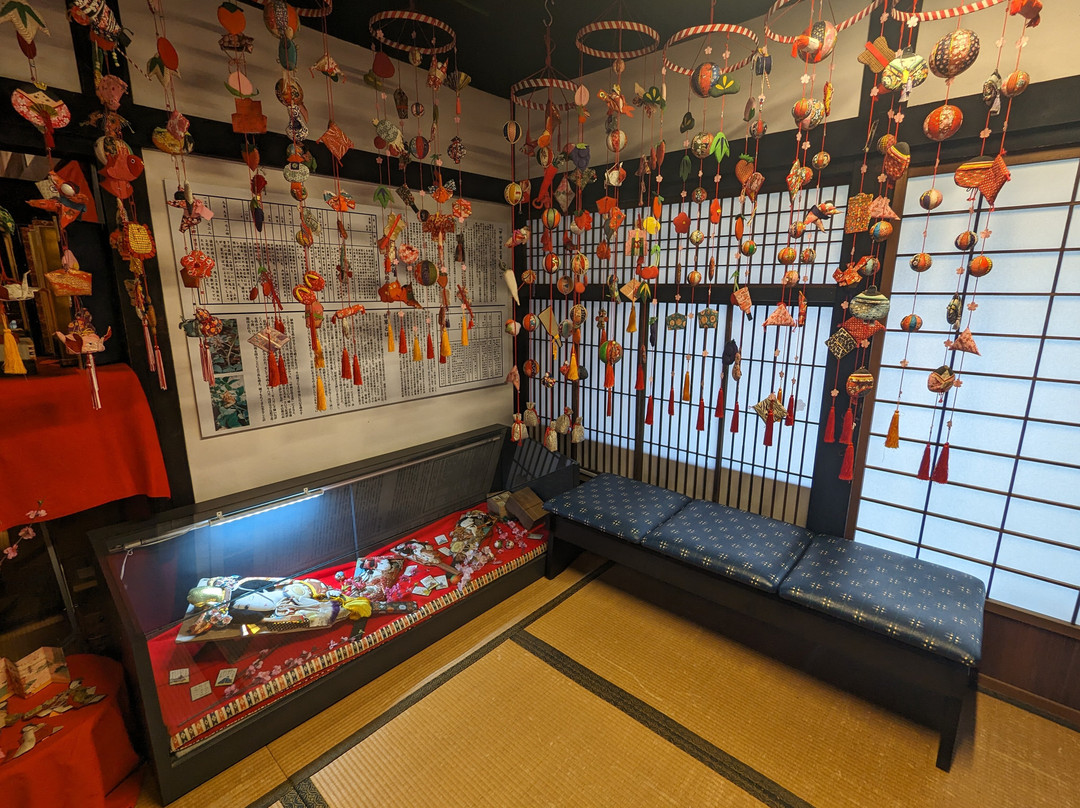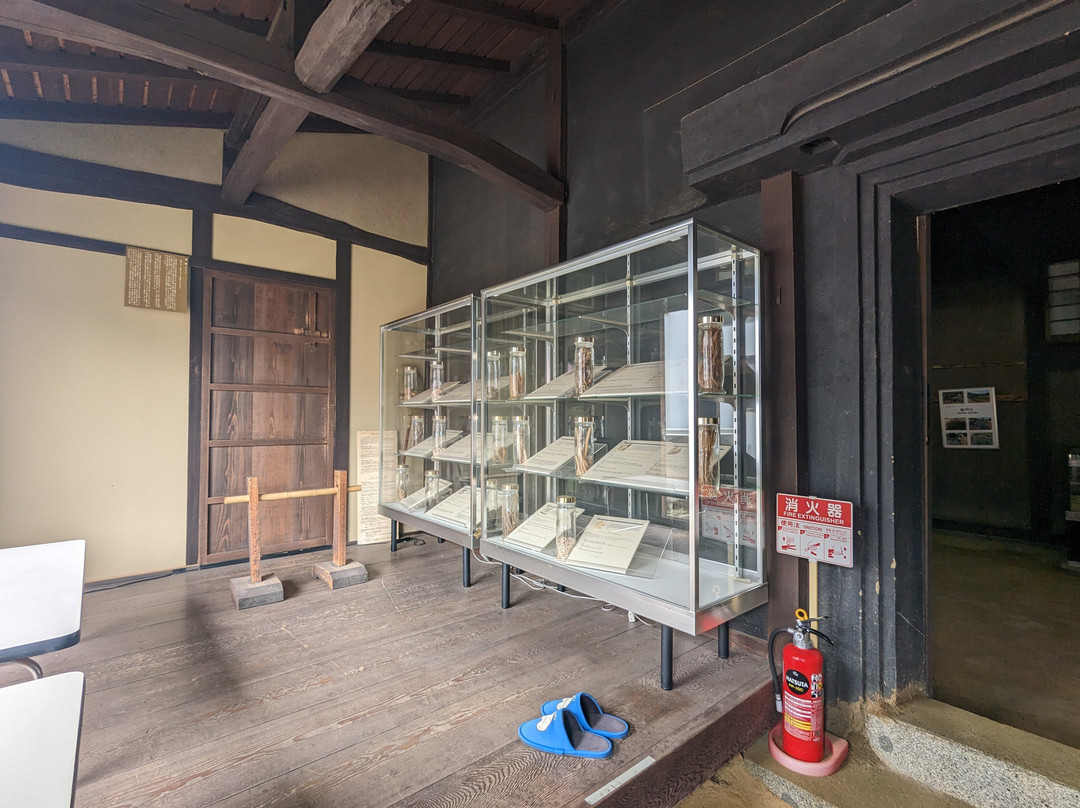的点评
Very accessible old residence of important cultural property, with a peaceful atmosphere
Kanzo Yashiki的点评
点评:かつて塩山の地で長百姓を務めた高野家の屋敷。江戸時代初期より薬草である『甘草』の栽培をしており、その甘草が徳川幕府の御用達に指定されたことから、『甘草屋敷』の呼び名がつけられた。
塩山駅から徒歩1分と非常にアクセスがよく、また塩山駅に停車する電車の本数も決して少なくはなく、都心から気軽にアクセス出来る重要文化財である。駅に近いにも関わらず鉄道の通過時などの音はどこか遠くに聞こえる、と感じる程にのどかで、ゆったりと江戸時代の家屋を鑑賞しつつ周遊するにはピッタリの場所と言える。
屋敷内はもちろん、敷地としても格別に広い、というわけではないため、全てを周遊するのに1時間は要しない。屋敷は3階構造になっているものの、公開されているのは1階のみで、複雑な造りにはなっていないため、屋敷内で迷う機会はまず無い。2月中旬から4月中旬にかけて、この屋敷に江戸時代から伝わる(あるいは寄贈された)ひな人形が所狭しと飾られ、屋敷内が一層豪華に映える。但し、休日でも混雑するほど人が訪れるわけではないため、ほぼいつでもゆったり屋敷を鑑賞できる、と言ってもいいだろう。
また、敷地内ではいまでも甘草を栽培しており、敷地内の蔵では甘草についての展示もされている。屋敷そのものの鑑賞ではなく、甘草そのものを知る上でも勉強になる施設だと思う。
The Takano family's residence, which was once the home of a wealthy farmer in Enzan. The family has been cultivating licorice, a medicinal herb, since the early Edo period, and the residence was given the name "Licorice Residence" because the Tokugawa shogunate designated the family as its official supplier of licorice.
It's an important cultural property that is easily accessible from the center of Tokyo, as it's only a one-minute walk from Enzan Station and there are also not a few trains that stop at Enzan Station. Despite its proximity to the station, the sounds of passing trains are a little distant, and it's a peaceful place that is perfect for taking a leisurely stroll while admiring the Edo-period house.
The grounds are not exceptionally large, so it doesn't take more than an hour to see everything. Although the house has three floors, only the first floor is open to the public, and as it's not a complicated structure, there is no chance of getting lost in the house. From mid-February to mid-April, the house is filled with hina dolls that have been handed down (or donated) from the Edo period, making the house even more luxurious. It's not so crowded that you can't see the house even on holidays, so you can almost always enjoy a leisurely visit.
In addition, licorice is still cultivated on the grounds, and there is also an exhibition about licorice in the storehouse on the grounds. I think this is a facility that is also educational for learning about licorice itself, rather than just appreciating the house itself.
塩山駅から徒歩1分と非常にアクセスがよく、また塩山駅に停車する電車の本数も決して少なくはなく、都心から気軽にアクセス出来る重要文化財である。駅に近いにも関わらず鉄道の通過時などの音はどこか遠くに聞こえる、と感じる程にのどかで、ゆったりと江戸時代の家屋を鑑賞しつつ周遊するにはピッタリの場所と言える。
屋敷内はもちろん、敷地としても格別に広い、というわけではないため、全てを周遊するのに1時間は要しない。屋敷は3階構造になっているものの、公開されているのは1階のみで、複雑な造りにはなっていないため、屋敷内で迷う機会はまず無い。2月中旬から4月中旬にかけて、この屋敷に江戸時代から伝わる(あるいは寄贈された)ひな人形が所狭しと飾られ、屋敷内が一層豪華に映える。但し、休日でも混雑するほど人が訪れるわけではないため、ほぼいつでもゆったり屋敷を鑑賞できる、と言ってもいいだろう。
また、敷地内ではいまでも甘草を栽培しており、敷地内の蔵では甘草についての展示もされている。屋敷そのものの鑑賞ではなく、甘草そのものを知る上でも勉強になる施設だと思う。
The Takano family's residence, which was once the home of a wealthy farmer in Enzan. The family has been cultivating licorice, a medicinal herb, since the early Edo period, and the residence was given the name "Licorice Residence" because the Tokugawa shogunate designated the family as its official supplier of licorice.
It's an important cultural property that is easily accessible from the center of Tokyo, as it's only a one-minute walk from Enzan Station and there are also not a few trains that stop at Enzan Station. Despite its proximity to the station, the sounds of passing trains are a little distant, and it's a peaceful place that is perfect for taking a leisurely stroll while admiring the Edo-period house.
The grounds are not exceptionally large, so it doesn't take more than an hour to see everything. Although the house has three floors, only the first floor is open to the public, and as it's not a complicated structure, there is no chance of getting lost in the house. From mid-February to mid-April, the house is filled with hina dolls that have been handed down (or donated) from the Edo period, making the house even more luxurious. It's not so crowded that you can't see the house even on holidays, so you can almost always enjoy a leisurely visit.
In addition, licorice is still cultivated on the grounds, and there is also an exhibition about licorice in the storehouse on the grounds. I think this is a facility that is also educational for learning about licorice itself, rather than just appreciating the house itself.
翻译:这里是曾经担任烟山地区主要农民的高野家族的住宅。江户时代初期就开始种植药草“甘草”,甘草被指定为德川幕府的御用供应商,因此得名“甘草屋”。
交通十分便利,距离燕山站步行仅需1分钟,而且在燕山站停靠的电车班次也不少,是从东京市中心可轻松前往的重要文化财产。虽然距离车站很近,但很安静,远处就能听到电车驶过的声音,是悠闲漫步、欣赏江户时代房屋的最佳场所。
由于宅邸本身和场地都不是特别大,所以游览整个区域不到一个小时。这座豪宅虽然是三层结构,但只有一层对外开放,而且结构并不复杂,所以在豪宅内部几乎没有迷路的机会。 2月中旬到4月中旬,宅邸内会装饰上江户时代传承下来的(或捐赠的)雏人偶,让宅邸内部显得更加奢华。不过,即使在节假日,参观的人也不会那么拥挤,因此您几乎可以随时悠闲地欣赏这座宅邸。
此外,场内还种植甘草,场内的仓库里还有关于甘草的展览。我认为这是一个不仅可以欣赏宅邸本身,还可以了解甘草本身的设施。
高野家的宅邸,曾经是远山富农的家。自江户时代初期起,家族就开始种植药草甘草,因德川幕府指定而被命名为“甘草宅邸”。该家族作为其甘草的官方供应商。
它是一个重要的文化财产,从东京市中心很容易到达,因为它距离燕山站只有一分钟的步行路程,而且停靠在燕山站的火车也不少。路过的电车距离稍远,环境清幽,非常适合一边欣赏江户时代的房屋一边悠闲地散步。
场地不是特别大,所以不需要一个多小时就可以看完所有的东西,虽然房子有三层,但只有一层对外开放,而且结构并不复杂,所以没有机会。从二月中旬到四月中旬,屋子里摆满了江户时代流传下来(或捐赠)的雏人偶,让屋子显得更加奢华。即使节假日也看不到房子,所以您几乎总是可以享受悠闲的参观。
另外,场地里还种植着甘草,场地里的仓库里还有一个关于甘草的展览,我想这也是一个有教育意义的设施,让我们了解甘草本身,而不仅仅是欣赏房子本身。
交通十分便利,距离燕山站步行仅需1分钟,而且在燕山站停靠的电车班次也不少,是从东京市中心可轻松前往的重要文化财产。虽然距离车站很近,但很安静,远处就能听到电车驶过的声音,是悠闲漫步、欣赏江户时代房屋的最佳场所。
由于宅邸本身和场地都不是特别大,所以游览整个区域不到一个小时。这座豪宅虽然是三层结构,但只有一层对外开放,而且结构并不复杂,所以在豪宅内部几乎没有迷路的机会。 2月中旬到4月中旬,宅邸内会装饰上江户时代传承下来的(或捐赠的)雏人偶,让宅邸内部显得更加奢华。不过,即使在节假日,参观的人也不会那么拥挤,因此您几乎可以随时悠闲地欣赏这座宅邸。
此外,场内还种植甘草,场内的仓库里还有关于甘草的展览。我认为这是一个不仅可以欣赏宅邸本身,还可以了解甘草本身的设施。
高野家的宅邸,曾经是远山富农的家。自江户时代初期起,家族就开始种植药草甘草,因德川幕府指定而被命名为“甘草宅邸”。该家族作为其甘草的官方供应商。
它是一个重要的文化财产,从东京市中心很容易到达,因为它距离燕山站只有一分钟的步行路程,而且停靠在燕山站的火车也不少。路过的电车距离稍远,环境清幽,非常适合一边欣赏江户时代的房屋一边悠闲地散步。
场地不是特别大,所以不需要一个多小时就可以看完所有的东西,虽然房子有三层,但只有一层对外开放,而且结构并不复杂,所以没有机会。从二月中旬到四月中旬,屋子里摆满了江户时代流传下来(或捐赠)的雏人偶,让屋子显得更加奢华。即使节假日也看不到房子,所以您几乎总是可以享受悠闲的参观。
另外,场地里还种植着甘草,场地里的仓库里还有一个关于甘草的展览,我想这也是一个有教育意义的设施,让我们了解甘草本身,而不仅仅是欣赏房子本身。








此点评仅代表旅行者个人的主观意见,并不代表TripAdvisor以及其合作方的意见。
关于我们
|新闻动态
|商务合作
|会员中心
|业主中心
|常见问题
|意见反馈
|联系我们
|营业执照
© 2025 Tripadvisor 版权所有。
使用条款 |隐私政策 |网站工作原理
部分照片由 VFM Leonardo 提供。
* Tripadvisor不是旅行社,也不是旅游预订服务代理商。我们提供免费、客观、公正的旅游资讯服务。 (显示更多)
TripAdvisor LLC 既不是预订代理商,也不是旅游运营商,不会向网站用户收取任何服务费。 按照规定,在 Tripadvisor 发布机票价格、游览和旅行套餐的合作伙伴(航空公司、旅行提供商及预订代理商),其标价须包含所有费用和附加费用。 例如, 机场出入境税费、消费税与其他服务费、手续费、杂费及附加费用。 当您向我们的某个合作伙伴进行预订时,请务必查阅他们的网站以了解当地行政部门要求的所有适用费用的具体情况。 除非另有说明,机票价格通常指的是一个人的价格(以人民币计)。
为方便起见,TripAdvisor LLC 根据从我们的预订合作伙伴获取的空房率计算每个酒店的均价。 对于游览和景点来说,所显示价格通常是每位成人的最低可用价格。 对于列出的任何旅行套餐或优惠,TripAdvisor LLC 无法保证任何特定的费率或价格。 此外,酒店均价每晚会更新,并以您的首选币种表示(使用现行汇率)。 由于这些已换算的价格是预估价格,因此,有关具体金额和币种请与预订网站进行核实。
此外,TripAdvisor LLC 无法保证我们网站上宣传的价格随时有效。 标价可能需要预订一定天数才能生效,或有不可用日期、使用条件或限制。
TripAdvisor公司对外部网站的内容一概不负责。优惠价格中不含税和其他费用。
ICP证:沪B2-20200433
沪ICP备20013175号
 沪公网安备31010502005427号
沪公网安备31010502005427号鹰程信息技术(上海)有限公司
货币/国家及地区
¥CNY
中国

